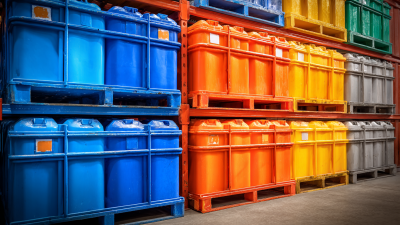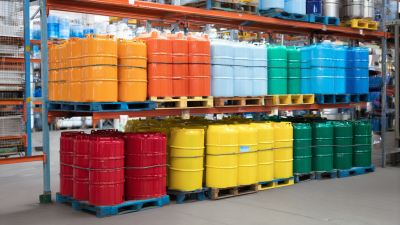
Blog
Unlocking Efficiency: The Top Benefits of Plastic Shipping Boxes for Your Business
In today's fast-paced business environment, optimizing packaging solutions is crucial for operational efficiency, cost-effectiveness, and environmental sustainability. According to a 2021 report by Smithers Pira, the global market for plastic shipping boxes is projected to reach $39 billion by 2025, driven by their lightweight nature and durability compared to traditional corrugated boxes. Plastic shipping boxes offer significant advantages such as weather resistance, reusable designs, and better stacking capabilities, which reduce shipping costs and improve supply chain logistics. As businesses strive to reduce their carbon footprints and enhance customer satisfaction, investing in plastic shipping boxes is not only a strategic choice but also a competitive advantage in the market. Embracing this innovative packaging solution can unlock efficiency, paving the way for a more streamlined and sustainable operation.

The Cost-Effectiveness of Plastic Shipping Boxes in Logistics
In today’s logistics landscape, the cost-effectiveness of plastic shipping boxes has become a pivotal consideration for businesses aiming to streamline their operations. Plastic shipping boxes are not only durable but also lightweight, which can significantly reduce shipping costs compared to traditional packaging materials. Their reusable nature leads to a further decrease in long-term expenses, as businesses can implement returnable transport packaging solutions, maximizing their investment and minimizing waste.
Moreover, the increasing emphasis on sustainability has made plastic shipping boxes a favorable option. Many companies are adopting a green logistics approach, integrating eco-friendly packaging solutions into their supply chains. By choosing plastic, businesses can enhance their environmental footprint while also adhering to sustainable practices. The versatility and resilience of plastic allow for better protection of goods during transit, reducing damage and enhancing efficiency. As logistics continues to evolve, the choice of plastic shipping boxes stands out as a practical method to achieve both profitability and sustainability in operations.
Enhancing Product Protection with Durable Plastic Containers
When it comes to shipping products, ensuring their protection during transit is paramount. Durable plastic shipping boxes offer a robust solution for businesses looking to safeguard their goods. Unlike traditional cardboard boxes, plastic containers are resistant to moisture, impacts, and chemical exposure, which significantly reduces the risk of damage. This resilience is particularly beneficial for industries that handle fragile items or products that require specific environmental conditions.
Moreover, the design of plastic shipping boxes often includes features like secure locking mechanisms and customizable interiors. These enhancements make them not only versatile but also capable of accommodating a wide range of products, from electronics to perishables. The reliability of plastic containers can lead to fewer returns and complaints, ultimately improving customer satisfaction and enhancing your brand's reputation. By investing in durable plastic shipping solutions, businesses can focus on their growth while ensuring their products arrive safe and sound at their destinations.
Unlocking Efficiency: The Top Benefits of Plastic Shipping Boxes for Your Business
| Benefit | Description | Impact on Cost | Sustainability |
|---|---|---|---|
| Durability | Resistant to damage, reducing the risk of product loss. | Lower replacement costs. | Can be recycled and reused, minimizing waste. |
| Weight | Lightweight design reduces shipping costs. | Lower overall shipping expenses. | Long-lasting containers mean fewer replacements. |
| Customizability | Ability to customize sizes and shapes based on product needs. | Optimizes storage and reduces wasted space. | Flexible designs can accommodate various products sustainably. |
| Weather Resistance | Protects goods from environmental damage. | Reduces returns due to damage. | Minimizes waste by preserving product quality. |
| Stackability | Designed for easy stacking, saving space. | Reduces storage costs and improves logistics. | Efficient use of space promotes sustainability. |
Eco-Friendly Solutions: Sustainability Benefits of Plastic Shipping Boxes
Plastic shipping boxes are increasingly recognized for their eco-friendly attributes, making them a popular choice among businesses looking to adopt sustainable practices. According to a report by the European Bioplastics Association, the use of recycled plastic in shipping materials can reduce carbon emissions by up to 30% compared to traditional cardboard packaging. This significant reduction underscores the positive impact recyclable plastics can have on environmental sustainability.
Moreover, plastic shipping boxes are designed for reuse, which inherently minimizes waste. The Corporate Sustainability Assessment by Morgan Stanley found that companies implementing reusable packaging systems can potentially divert up to 36% of their packaging waste from landfills. This aligns with the global initiative aimed at reducing single-use plastics, promoting a shift towards a circular economy where materials are continuously repurposed. As consumers become more environmentally conscious, businesses utilizing sustainable plastic shipping solutions are not only contributing to a healthier planet but are also enhancing their brand reputation among eco-aware customers.
Unlocking Efficiency: The Top Benefits of Plastic Shipping Boxes for Your Business
Maximizing Storage Efficiency with Stackable Plastic Shipping Solutions
When it comes to streamlining logistics and optimizing warehouse space, stackable plastic shipping boxes offer an unmatched solution. These innovative containers are designed to efficiently utilize vertical space, allowing businesses to maximize storage capacity without compromising accessibility. By employing stackable designs, companies can create organized systems where items are not only easy to retrieve but also stored in a way that minimizes wasted space, making the most of every square foot in a warehouse.

Moreover, the durability of plastic shipping boxes contributes significantly to operational efficiency. Unlike cardboard, plastic is resistant to moisture, pests, and wear, ensuring that goods are protected during transit and storage. This resilience reduces the need for frequent replacements, thus lowering long-term costs. Additionally, the uniform shape and size of stackable plastic boxes enable a streamlined stacking process, further enhancing the workflow in busy environments. As a result, employees can work more efficiently, leading to improved productivity and ultimately, better service for customers.
Streamlining Operations: Seamless Transport and Handling of Goods
 In today's competitive market, businesses are recognizing the importance of optimizing logistics operations for achieving seamless transport and handling of goods. One effective solution is the adoption of plastic shipping boxes, which are quickly becoming a preferred choice for many organizations. Unlike traditional shipping materials, plastic boxes provide enhanced durability, resistance to moisture and contaminants, and the ability to stack easily, all of which streamline handling processes and reduce the risk of damage during transit.
In today's competitive market, businesses are recognizing the importance of optimizing logistics operations for achieving seamless transport and handling of goods. One effective solution is the adoption of plastic shipping boxes, which are quickly becoming a preferred choice for many organizations. Unlike traditional shipping materials, plastic boxes provide enhanced durability, resistance to moisture and contaminants, and the ability to stack easily, all of which streamline handling processes and reduce the risk of damage during transit.
As logistics costs rise globally, particularly in regions like Bangladesh, leveraging innovative solutions becomes essential. The use of plastic shipping boxes can significantly cut operational costs, enabling businesses to deliver products efficiently while maintaining the integrity of their shipments. Additionally, with the shift towards digital logistics, integrating these boxes into a comprehensive supply chain framework allows for improved tracking and management of goods, ensuring organizations can make data-driven decisions that enhance overall performance. The transition to plastic shipping solutions is not just a logistical change; it is a strategic move towards sustainable operations in an evolving market landscape.
Related Posts
-

2025 Trends in Plastic Bulk Containers: A Comprehensive Guide to Innovations and Best Practices
-

The Future of Ecofriendly Take Out Food Containers
-

Exploring the Best Options for Bulk Plastic Bottles A Comprehensive Comparison Guide
-

Ultimate Guide to Sourcing Bulk Containers for Your Business Needs
-

The Ultimate Checklist for Choosing the Right Plastic Bottles for Your Business Needs
-

Ultimate Guide to Specifications of the Best Plastic Bulk Containers for Global Buyers
